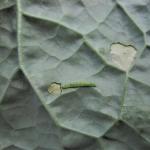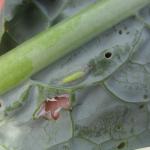Diamondback Moth
Platella zylostella
Diamondback moth is a pest of all brassica crops and is present throughout the growing season. Diamondback moth feeds on all plant foliage, rather than concentrating its feeding in the head like imported cabbageworm.
Identification:
Diamondback moth (DBM) adults are the smallest of the brassica lepidopteran pests (<1/2 inch), light brown with a yellow diamond-shaped marking, and rest with their wings folded together like a tent. Historically DBM did not overwinter in the Northeast, but caterpillars have been reported by May in recent years, suggesting that they may be overwintering in high tunnels or other warm spots. Regardless, this pest also blows in every year from warmer areas to our south. Adults are weak fliers, but populations are known to disperse long distances on wind and annually reinvade areas well into Canada. Eggs are laid singly or in small clusters. Caterpillars go through four instars and are small (< ½ inch when fully grown), light green, and appear segmented, with a forked end and pointed shape. When disturbed they wiggle vigorously and may drop off the plant on a string of silk. Feeding causes small, round holes that don’t break through the top layer of leaf tissue, leaving translucent films across holes, called “windowpane” damage. Feeding tends to be spread across the foliage and not necessarily concentrated in the head.
Monitoring & Thresholds:
Scout fields by checking leaves (underside) on 25 plants across the field. In the Northeast, there is generally no need to treat young plants unless weather conditions delay plant development and at least 35% of them are infested with any of these pests. Treat plants between the start of heading and harvest if 20% or more of the plants are infested. The most critical time to scout and apply controls is just prior to head formation. Use a 10-15% threshold throughout the season for kale, collards and mustard.
Cultural Controls & Prevention:
-
Incorporate crop residues shortly after harvest to reduce movement to successive plantings and reduce overwintering populations.
-
Use selective materials or microbial products to spare beneficial insects that help control aphids, DBM and ICW populations.
Chemical Control & Pesticides:
Do not use less than 50 gal spray material/A; higher volumes provide better coverage. Better coverage of lower leaf surfaces can be achieved by using drop nozzles. Use a spreader-sticker.
Diamondback moth has become resistant to many synthetic and microbial insecticides. Even if you are getting excellent control of this pest with the materials presently being used, you should alternate between effective materials to retard development of resistance. Newer materials and the aizawai strain of Bacillus thuringiensis will usually provide better control of resistant DBM than older products. Use transplants grown in New England to avoid importing DBM that have already developed resistance to one or more classes of insecticides.
For current information on production methods (including varieties, spacing, seeding, and fertility), weed, disease, and insect management, please visit the New England Vegetable Management Guide website.
Crops that are affected by this insect:
The Center for Agriculture, Food and the Environment and UMass Extension are equal opportunity providers and employers, United States Department of Agriculture cooperating. Contact your local Extension office for information on disability accommodations. Contact the State Center Director’s Office if you have concerns related to discrimination, 413-545-4800 or see ag.umass.edu/civil-rights-information.

